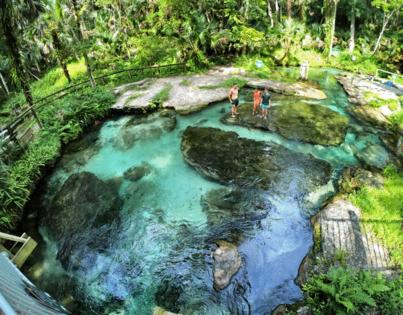Should a 'Florida Springs National Park' be created? Environmental advocates are torn
Published in Science & Technology News
ORLANDO, Fla. — A Florida congressman’s proposal to stitch together a patchwork of springs in North and Central Florida into the country’s 64th national park won’t help protect the state’s outstanding, and crucial, freshwater resource, springs advocates say.
U.S. Rep Randy Fine’s Path to Florida Springs National Park Act would direct the federal government to conduct a study on how to make the springs located across 2,800 miles of land into a national park. The land encompassing the various springs is south of Jacksonville, north of Orlando and east of Gainesville and includes the Ocala National Forest, the Lower Wekiva River Preserve State Park and the Rock Springs Run park that spans Orange, Lake and Seminole counties.
“We are the Yellowstone of springs,” said Fine, R-Melbourne Beach, at a press conference at Ocala National Forest on Aug. 25. “It’s imperative that we develop in a sustainable way and don’t ruin what Florida has.”
His bill calls Florida’s springs “as miraculous as any other national asset we have in this country.”
Fine said he has visited every national park, including Yellowstone National Park in Wyoming, but was still blown away by Florida’s springs.
“When my kids were born … I made a decision that I would take them to every national park in the U.S.,” Fine said. “Just a few months ago … I visited the springs and I thought, ‘Why are these not protected?'”
While leading conservation advocates say the study would add valuable research, some doubted a national park designation — which could massively increase visitation and traffic — would ultimately help with the major issues threatening the natural marvels.
Florida’s more than 1,000 springs — the largest concentration of freshwater springs in the world — are under threat from development, agricultural pollution and climate change. The health of the springs are vital as they’re directly linked to 90% of the state’s drinking water.
“Changing state parks or state forests into national forests or national parks doesn’t do any of the things that need to be done to actually restore the springs,” said Ryan Smart, the executive director of the non profit Florida Springs Council which advocates for the protection and preservation of springs statewide. “The harm that’s happening to the springs is because of land uses on private property around the springs.”
Reducing pollution, getting rid of nearby septic tanks and limiting consumptive use permits, or the regulated amount of water allowed to be taken from the Florida aquifer, are all important actions to help restore the springs, Smart said. None of these actions are in the bill.
“It’s not that we don’t need additional protections, it’s just that this doesn’t provide any,” Smart said. “All of the means for protecting the springs are regulated at a state level.”
Smart said the federal government could help by providing funding for these projects, but it’s not tied to the creation of a national park.
Fine argued the main purpose of the bill was to protect the springs. But with the recent passage of the State Park Preservation Act, signed into law in May by Gov. Ron DeSantis, it may render the federal designation moot, Smart said.
The act protects the state’s 175 state parks from development and brought to a close the state’s controversial plan to build golf courses, luxury lodges, pickleball and tennis courts at three state parks.
“At this point, I think it’s safe to say that our state parks are as well protected as our national parks are,” Smart said. “And we have much more say over what happens at the state level than the federal level.”
Under President Donald Trump’s administration, the National Park Service is in crisis as Department of Government Efficiency, or “DOGE”, budget cuts have led to the loss of nearly a quarter of its employees.
Despite a court order to rehire many of those laid off, staffing is still not back to normal.
Smart said the contrast between the state’s bipartisan effort to ensure parks are protected and the federal government’s actions are “worrisome.”
“It worries me that we would take something that [belongs to] the citizens of Florida … and we would give them up to another level of government that we will have less say or input,” Smart said. “Things change at the federal level.”
But Julie Wraithmell, vice president and executive director of Audubon Florida, said the proposal isn’t all bad.
The study, she said, is “really important, because it will evaluate the feasibility, identify any potential unintended consequences and hopefully explore what the biggest opportunities for improving conservation of our springs,” Wraithmell said. “Congressman Fine has breathed new life into the discussion of just how absolutely world class Florida Springs are.”
A change in management from state to federal may limit swimming at the springs and the fees visitors pay may change, Wraithmell said. But overall, she said, a state park visitor and a national park visitor may not notice the change.
The bill was introduced to the house in July and assigned to the House Committee on Natural Resources, where legislators will hold hearings and revise it before passing it to the full chamber for a vote. If it successfully passes the House, the Senate will begin a similar process and then sent to Trump for his approval or veto.
If it becomes law, the Interior Department has three years to complete the study and evaluate if the designated area contains nationally significant resources and report its findings.
-------------
©2025 Orlando Sentinel. Visit at orlandosentinel.com. Distributed by Tribune Content Agency, LLC.







Comments